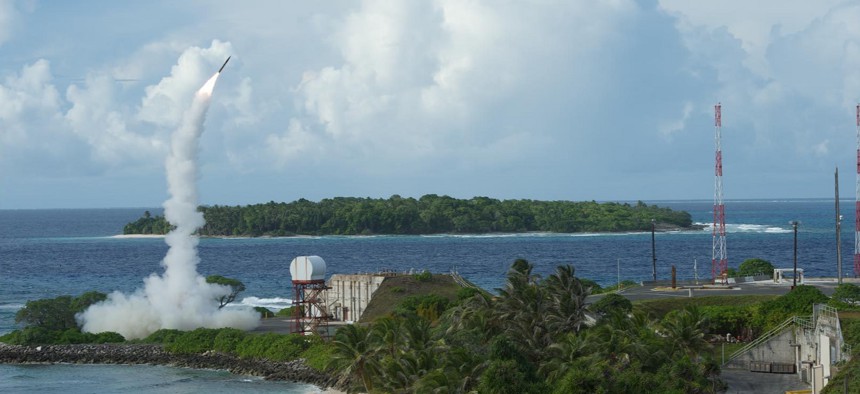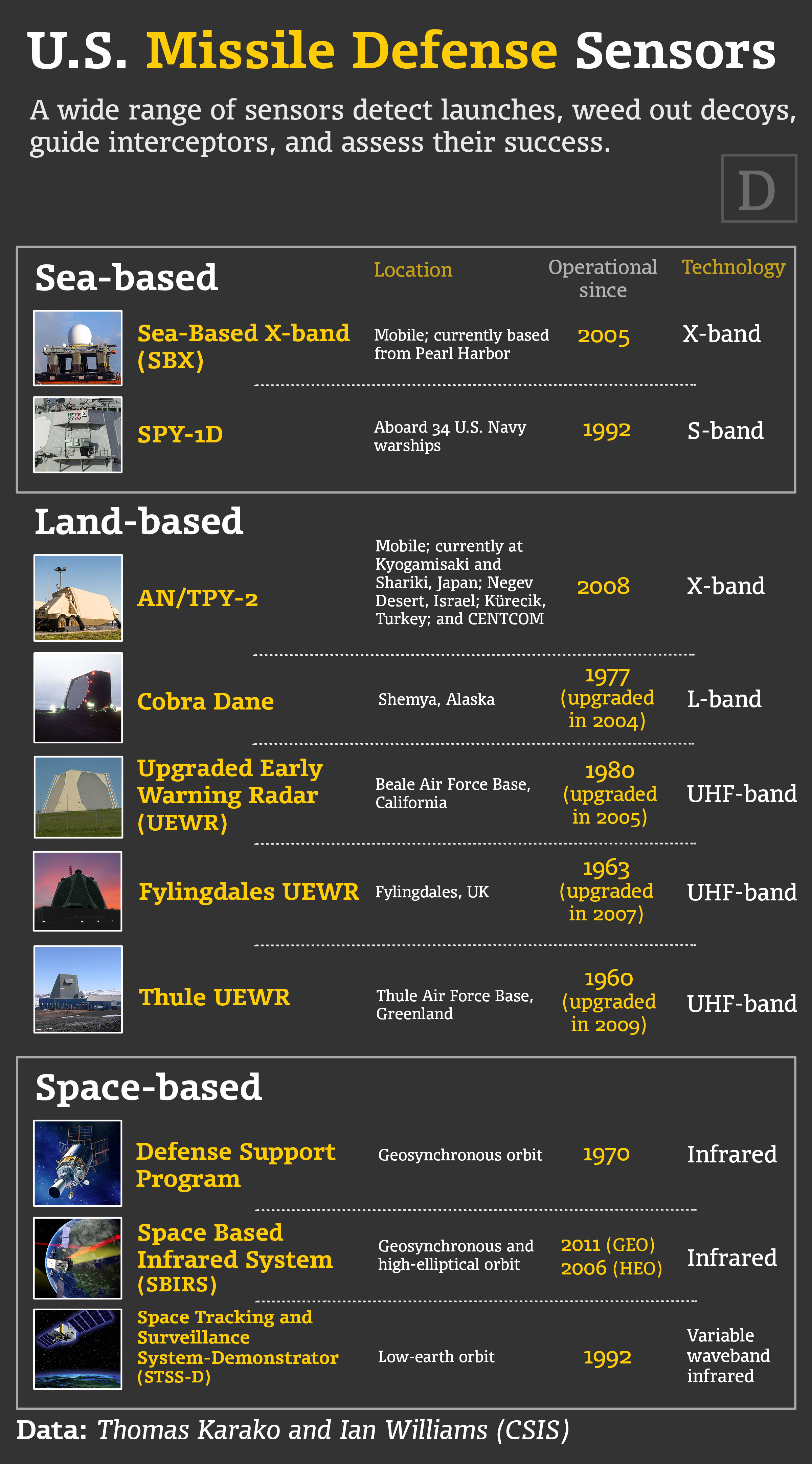
The second of two Terminal High Altitude Area Defense (THAAD) interceptors is launched during a successful intercept test. Missile Defense Agency
US Missile Defenses Need Better Sensors, and Soon
Gaps in coverage leave interceptors less-equipped to defeat the threats of tomorrow.
No missile defense is better than the sensors that tell the interceptors where to go and what to kill. The Ground-based Midcourse Defense system, or GMD, draws upon considerably more sensors for homeland defense than when operations began in 2004, but shortfalls remain. The North Korean and other missile threats are not diminishing, and it’s time to get this right.
In a forthcoming report, we recommend that the Defense Department and Missile Defense Agency take several steps to improve the sensor backbone of America’s homeland missile defenses, including fielding a space layer, filling radar gaps, adding omnidirectional focus, and improving command and control. Unfortunately, the budget for missile defense sensors has fallen considerably over the past decade, exactly the wrong trend for our changing security environment.
Gaps in the Architecture
The sensors supporting homeland missile defense include both some of the newest and oldest ones currently operating. An enemy missile launch would be detected first by satellites tuned to spot the heat of a firing rocket motor. Yet their infrared sensors cannot track a missile much after its engine burns out, and do not in any case provide enough data to conduct an intercept.
For the demanding tasks of missile tracking and discrimination, the global Ballistic Missile Defense System largely relies on large ground-based radars: five upgraded Cold War-era Early Warning Radars; the Cobra Dane surveillance radar on Shemya, Alaska; and five newer forward-deployed TPY-2 X-band radars. When they are deployed to the right place, the Navy’s SPY-1 radars on Aegis ships and floating Sea-Based X-band radar, or SBX, also provide important help.
These radars help track incoming missiles in different ways, depending on their location and capabilities. Lower-frequency radars like the early warning radars are better for tracking over great distances, while the higher-frequency X-band radars are best at discriminating the warhead from accompanying debris. All these terrestrial sensors, however, are limited by the curvature of the earth.
To be sure, ground- and sea-based radars will continue to play critical roles, but the first and possibly most important step to improving global missile defense capabilities is to create and field a space sensor layer for persistent, birth-to-death missile tracking and discrimination. “Given where the threat is going,” MDA director Vice Adm. James Syring said last year , “persistent tracking and discrimination capability from space is a must.”
Each of the last five presidential administrations has had space-based infrared sensors as a key component of their planned missile defense architectures—at least on paper—but none has yet deployed one. Two demonstrator satellites called STSS are currently on orbit, but they do not operationally contribute, and a larger constellation would be needed to do so. Last year, a campaign memo for president-elect Donald Trump pledged to create just that, endorsing “a comprehensive ballistic missile defense system with a heavy emphasis on space-based early warning and missile tracking technologies.”
This is exactly what is needed, but there’s still no concrete plan to deploy it.
One obstacle is cost, which is why MDA’s Space-based Kill Assessment experiment aims to put a sensor payload on a commercial satellite, to help determine whether interceptor missiles had destroyed their target, or whether another salvo is needed. If successful, this model of commercial hosting could help defray launch costs and lead to a larger, more distributed constellation of smaller and less-expensive satellites.
But until a space layer is fielded, U.S. missile defenses will have too few sensors to definitively discriminate warheads from debris or decoys, which means that more interceptors will need to be fired to ensure a kill, which in turn reduces the effective magazine. The 37 Ground-based Interceptors currently deployed in Alaska and California could be challenged by a larger missile salvo. The emergence of hypersonic boost glide vehicles maneuvering in the high endo-atmosphere and other new threats will further tax terrestrial radars.
Filling the Gaps
Second, the United States should continue to improve the global quality and redundancy of ground-based radar sensors, both in the Pacific and elsewhere.
To narrow some of the coverage gap in the Pacific for tracking North Korean missiles, MDA is building the Long-Range Discrimination Radar, or LRDR, at Clear Air Force Station, Alaska. Scheduled for initial operations around 2020, its S-band radar will discriminate less well than an X-band radar but provide a greater field of view.
The LRDR is being built at Clear rather than the more remote Shemya island, some 1,500 miles southeast at the end of the Aleutian chain. This new location will reduce operating costs, but may also leave a coverage gap after a North Korean missile overflies the TPY-2 radars in Japan, and will reduce coverage for missiles that might threaten Hawaii. To compensate, MDA is studying a proposal to build a single-faced Medium Range Discrimination Radar in Hawaii to help Alaska-based interceptors protect America’s southernmost state. Other options include alternate high-frequency radars on Hawaii that might provide a cheaper and nearer-term solution if the Aegis Ashore test range at Kauai were to be operationalized and equipped with the Standard Missile IIA , which is scheduled to become available next year.
In general, a more distributed sensor architecture would improve effectiveness and resilience. Today’s regional and homeland missile defenses have too many single points of sensor failure. Most of NATO missile defense is supported, for instance, by a single TPY-2 in Turkey, and the only-sometimes deployed SBX remains all too critical for discriminating North Korean threats to the homeland. MDA should therefore continue to add redundancy and expand coverage.
Third, the United States should explore options for adding a radar on or near its Atlantic coast. Today’s sensor upgrade efforts are largely aimed at the North Korean problem, but there remains a near-total lack of late-midcourse discrimination for any missile coming from the Middle East.
When the radar at Clear is ready, SBX could be moved to the Atlantic seaboard, but that would end its usefulness in testing GMD and gathering information on North Korean missile tests. Other options might bring the SBX radar ashore or build another ground-based radar. X-band radars could be installed near the Upgraded Early Warning Radars at Fylingdales or Thule, or at some other location, perhaps either with a new East Coast interceptor site or even in Canada. In the longer term, more high-frequency radars will likely be needed. As the SBX dilemma suggests, there are currently just not enough high-frequency radars to go around.
Command and Control
A fourth but closely related area concerns the command-and-control systems that make missile defense possible. The world’s best sensor data is useless unless it can be fused, integrated, and effectively employed, a challenging task for an effort that is global in scope. The GMD Fire Control system takes data from the Command and Control Battle Management and Communications network, integrates it with other sensor data, and crafts an engagement plan and firing solution. Fire control information is continuously fed, via Inflight Data Terminals, to interceptors in flight. Critical evolution and regular updates to these and other ground systems must not be overlooked.
The Path Forward
Fast-moving interceptors tend to get more attention, but sensors are the real spine of the missile defense mission. Indeed, sensors are critical to each part of the kill chain: launch detection, tracking, classification, discrimination, fire control, divert, intercept, and kill assessment. The sensor architecture to protect the United States has drastically improved since 2004, but still falls short of the persistent, birth-to-death tracking and discrimination. The utility of a space sensor layer, closing terrestrial radar gaps, and the need to defeat more complex threats are well understood in principle. Now it is time to make these capabilities a reality.





